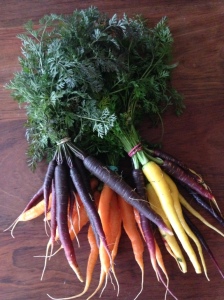Link:
https://botanistinthekitchen.blog/2017/09/23/carrot-top-pesto-through-the-looking-glass/
Posted on September 23, 2017 by Jeanne L. D. Osnas
https://botanistinthekitchen.blog/2017/09/23/carrot-top-pesto-through-the-looking-glass/
Posted on September 23, 2017 by Jeanne L. D. Osnas
Isomers are molecules that have the same chemical constituents in different physical arrangements. Some terpenoid isomers have very different aromas and are important food seasonings. A batch of carrot top pesto led to an exploration of intriguing terpenoid isomers in the mint, carrot, and lemon families.
“Oh, c’mon. Try it,” my husband admonished me with a smile. “If anyone would be excited about doing something with them, I should think it would be you.”
The “them” in question were carrot tops, the prolific pile of lacy greens still attached to the carrots we bought at the farmer’s market. I have known for years that carrot tops are edible and have occasionally investigated recipes for them, but that was the extent of my efforts to turn them into food. My excuse is that I harbored niggling doubts that carrot tops would taste good. Edible does not, after all, imply delicious. My husband had thrown down the gauntlet, though, by challenging my integrity as a vegetable enthusiast. I took a long look at the beautiful foliage on the counter.
“Fine,” I responded, sounding, I am sure, resigned. “I’ll make a pesto with them.”
Carrot tops, it turns out, make a superb pesto. I have the passion of a convert about it, and not just because my carrot tops will forevermore meet a fate suitable to their bountiful vitality. The pesto I made combined botanical ingredients from two plant families whose flavors highlight the fascinating chemistry of structural and stereo isomers.

Nenhum comentário:
Postar um comentário